
The Different Types of Mortgage Loans for Homebuyers
Not all USA mortgage loans are created equally. USA mortgage guidelines outline available options with regards to particular real estate investments based on: property price, credit scores and location. The Federal Housing Finance Agency (FHFA) sets the USA mortgage limits.
Pros and Cons of Conventional mortgages
A conventional USA mortgage is a type of loan not secured by a government entity. Businesses such as banks, mortgage companies or credit unions offer conventional mortgages in the US. Other alternatives include government-sponsored enterprises. The only two US government-sponsored mortgage enterprises are the Federal National Mortgage Association (or Fannie Mae) and the Federal Home Loan Mortgage Corporation (or Freddie Mac)
A conventional mortgage loan can be conforming or non-conforming.
Conforming conventional USA mortgage
- Guidelines are set the two government-sponsored enterprises Fannie Mae and Freddie Mac.
- Secured with collateral
- The maximum loan amounts are set by the FHFA
- Loan amounts differ by county
- This type of mortgage in America for foreigners is only available with residency permit
- As of 2019, most counties generally offer a maximum of:
| One unit property | $484,350 |
| Two unit property | $620,200 |
| Three unit property | $749,650 |
| Four unit property | $931,600 |
Non-conforming conventional USA mortgage
- Greater mortgage loan amounts
- Unsecured loan
- This type of mortgage in America for foreigners is available with a social security number
- Does not follow FHFA guidelines
- Most common loan type is known as jumbo USA mortgage
- Designed to finance more expensive, high-end properties
- Loan seekers should have a strong credit score
| Pros | Cons |
| Higher down payment means that equity is built up faster | Higher down payment is more challenging to achieve |
| Higher down payments means less likely to have PMI* | The money for the loan requires authentication |
| Can be fixed or adjustable interest rates | Low credit scores means higher interest rate |
| More open for negotiations | Additional fees may be part of the loan terms |
| Loan is processed faster | Non-refundable fee for loan application |
| Debt-to-income ratio is considered (could be a pro) | Debt-to-income ratio is considered (could be a con) |
| Fewer restrictions on applicant’s financial situation | Strict prepayment penalties |
*Private mortgage insurance
Jumbo USA mortgages
The jumbo loan is a non-conforming conventional USA mortgage that exceeds the loan limits set by the FHFA. Jumbo loans are not purchased or securitized by Fannie Mae or Freddie Mac. Loan seekers are generally required to have strong credit scores. The down payment is between 10% and 20% of the total purchasing price (or more). The Jumbo loan is riskier to lenders since there is no guarantee from Fannie Mae or Freddie Mac, and the money amount is significantly higher. This type of mortgage in America for foreigners is available with a social security number.
Government-insured USA mortgages
A government-insured USA mortgage is a loan backed by the US government. This is done to ensure repayment to the bank should there be any mortgage payment issues. This type of mortgage in America for foreigners is available with permanent residence. There are three types of government-insured mortgage companies:
- The Federal Housing Authority (FHA loan)
- Department of Veterans Affairs (VA loan)
- US Department of Agriculture (USDA loan)
| FHA | VA | USDA |
| Eligible for those with low-to-medium income | Eligible for American 1. Veterans 2. Active duty military, 3. National Guards, 4. Spouses of veterans |
Eligible for those with low-to-medium income |
| 3.5% down payment | 0% down payment | 0% down payment |
| Mortgage insurance needed | No Mortgage insurance | Mortgage insurance needed |
Fixed-rate mortgages
A FRM USA mortgage loan one that includes a stable interest rate throughout the length of the loan term. This means that your loan payment stays the same each month.
Adjustable-rate mortgages
ARM USA mortgages, sometimes called variable-rate mortgages, have a periodically changing interest rate. This change corresponds with the financial index of the loan of the bank. This means that the monthly payment may increase or decrease depending on the index rate of that month.

New construction loan
The new construction loan covers the cost of building a new house. In some cases, this includes major renovations to an existing home including the plot of land. The two most common new construction loan types are the construction-to-permanent loan and standalone construction loan.
| Construction-to-permanent (C2P) | Standalone construction loan |
| Converts to standard mortgage after construction | Short term loan for funding home construction |
| During construction only interest is paid | When construction is finished, the loan is simply paid off |
| Once the loan is closed, it cannot be undone easily | Must pay two sets of closing costs |























